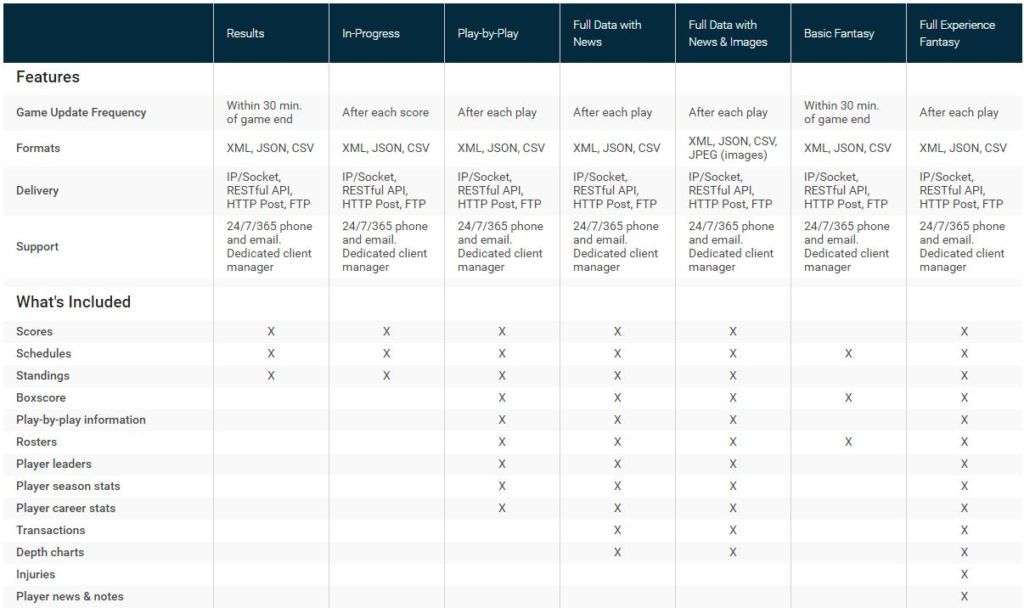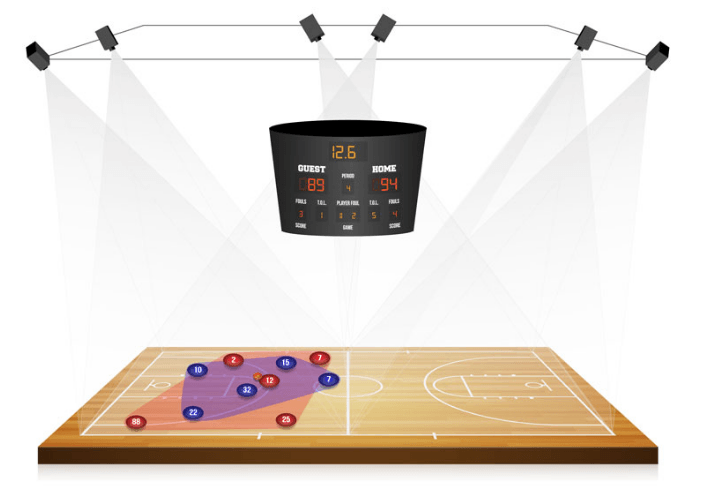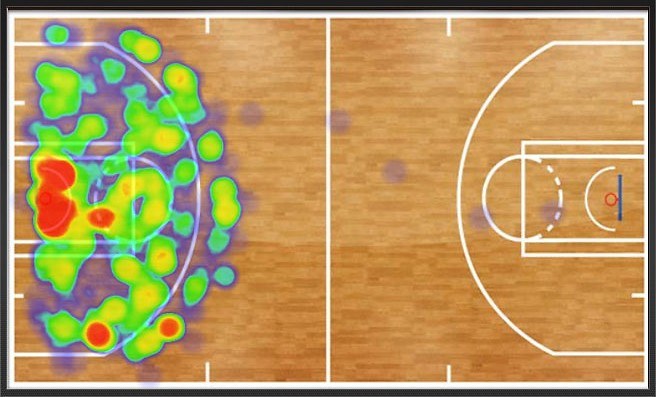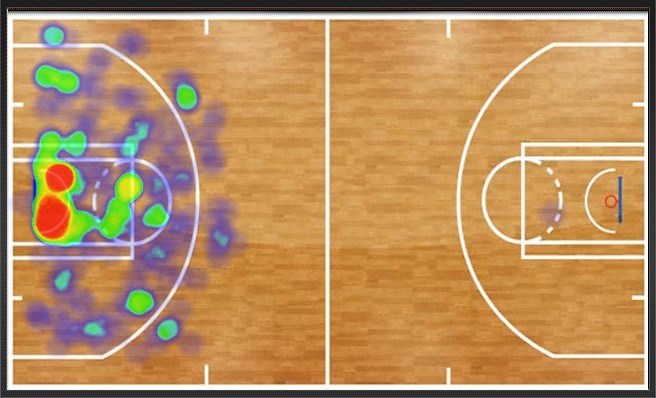Behind Moneyball 2.0 Stands STATS

A five-time NBA Most Valuable Player and a twelve-time All-star, Bill Russell once said, “the only important statistic is the final score.” But is it really? New digital platforms and technologies have transformed the business of sports to be ever more scientific in its approach. At the center is STATS, a company priding itself in providing the fastest, most accurate data in sports.
Sports Team Analysis and Tracking Systems (STATS LLC) is a global company that provides real-time scores, historical sports information, editorial contents and game analysis. Since its inception in 1981, STATS has grown into a single source provider for data and content from over 45 leagues and sporting events around the world.

New datafication enabled by the acquisition of SportVU
Numerous technological breakthroughs have enabled datafication of virtually any detail in a sports game. STATS realizes a huge potential in this untapped market. In 2010, it acquired an Israeli company called SportVU, which repurposed its missile tracking technology for use in sports. SportVU’s system captures the X/Y coordinates of all the players and references in a game along with 3D coordinates of the ball through recognizing all sorts of visual signals from lines on the court to reflections of flashing billboards.

Shortly after the acquisition, STATS launched a pilot with few teams in National Basketball Association (NBA) and installed a six-camera system in basketball arenas that tracks the real-time positions of players and the ball 25 times per second as shown in Exhibit 2 [1]. Utilizing this tracking data, STATS goes beyond statistics traditionally based on binary events such as number of offensive rebounds or field goal to innovative statistics with the context of a game—speed, distance, player separation, ball possession etc. This new vast array of information can create new moneyball 2.0—everything from training, player valuation to scouting. One example is Kevin Durant’s closely guarded attempts vs successful shots. While his attempts happen all over the court, he only makes his shots in a few select areas. With new piece of information, Golden State Warriors coaches can train him to either make few attempts outside his comfort zone or practice shooting in the spots.


Diversifying revenue streams through new value-added services
STATS pays professional leagues to capture raw data and in turn licenses standard statistics and analytics for publishers and leagues. In 2014, 70% of its $60 million revenue comes from licensing standard statistics and providing analysis for more than 200 leagues worldwide. But through SportVU, it now charges about $100,000 per each NBA team for the very data. While relatively small now, this new revenue stream represents the company’s fastest growing business, doubling over 2012-2014 each year. [2].
However, providing raw data and relatively simple analysis offers limited value creation for the leagues. While the most value-add lies in interpreting data and extracting actionable insights, STATS is still playing a passive role of recording and supplying data rather than that of distilling insights.
Therefore, STATS started to look for ways to expand its coverage in sports industry. New mission was to switch to the analytics-driven, value-generating model. Multiple acquisitions followed to strengthen its capabilities. In 2011, STATS acquired high stakes in National Fantasy Championship, setting the first step in the world of fantasy sports, the market of $26B [3]. Subsequent acquisition of data analytics specialist company, Bloomberg Sports in 2014, enabled the company to launch a new product that projects predictions for fantasy sports. Bloomberg Sports possesses quantitative models and algorithms that STATS once had to outsource a third party to, making it a perfect chance for STATS to diversify its portfolio. Most recently in 2015, it further strengthened its technology and geographic base by acquiring Prozone—a UK based company that tracks and analyzes athlete performance, maintaining a database of 100,000 players in four continents. Combining existing product suite in real-time data and analytics, STATS attempts to deliver more values to a broader range of customers around the world [4].
Will it be able to take the lead?
While STATS has attempted to diversify its revenue stream through shifting gears towards more value-adding sophisticated analytics and e-sports area, its fundamental business model is susceptible to competitions. Few large B2B accounts such as NBA league or professional teams still account for a majority of its revenue. Partnership deals may easily fail to be extended either because the leagues choose to internalize the role STATS has been playing or because other competitors can offer better packages. In fact, Major League Baseball (MLB) announced it would install a system called Statcast in 30 stadiums and provide data for every game, coming down to ~7 terabytes, for free through its subsidiary MLB Advanced Media [5]. Moreover, NBA which has been the strongest proponent of its motion-tracking technology handed over its data capturing and distribution deal to its rival Sportradar; SportVU’s player-tracking cameras will be replaced with Sportradar’s equivalents [6].
Will STATS be able to take the lead in sports technology sector? Unless STATS brings in unmatchable innovative technologies and product differentiation, it may find itself losing more market share to once-their-customers-now-contesting leagues and similar sports data analytics competitors.
(Word Count: 786 words)
Bibliography
[1] Wilson, Mark, “Moneyball 2.0: How Missile Tracking Cameras Are Remaking The NBA”, https://www.fastcodesign.com/1670059/moneyball-20-how-missile-tracking-cameras-are-remaking-the-nba, assessed Nov 17, 2016.
[2] Ecker, Danny, “Stats LLC sold to private-equity firm”, http://www.chicagobusiness.com/article/20140515/BLOGS04/140519841/stats-llc-sold-to-private-equity-firm, assessed Nov 17, 2016.
[3] Wong, Kristin, “The Fantasy Sports Industry, by the Numbers”, http://www.nbcnews.com/business/business-news/fantasy-sports-industry-numbers-n439536, assessed Nov 18, 2016.
[4] STATS official homepage, “STATS Unveils New Global Brand Identity”, http://www.stats.com/press-releases/stats-acquires-prozone, assessed Nov 18, 2016.
[5] Darrow, Barb, “Live from Fenway Park, a behind-the-scenes look at MLB Statcast”, http://fortune.com/2015/09/04/mlb-statcast-data/, assessed Nov 17, 2016.
[6] Leung, Diamond, “STATS Rebrands, Regroups After Losing NBA Partnership To Rival Sportradar”, http://www.sporttechie.com/2016/09/27/sports/nba/stats-rebrands-after-losing-nba-partnership-to-rival-sportradar/, assessed Nov 15, 2016.



Selene – Thanks for writing this article. I agree with you that while STATS is able to acquire statistics and analytics on teams in the NBA and other sports, the real value is in how the data is interpreted and used. It seems that STATS wasn’t able to provide that key insight and was replaced by its competitor because they were less expensive. One question I have is regarding your example about Kevin Durant’s shooting patterns. While this information is useful for training and coaching him, what if that exact data is licensed by every other NBA team? This would give other teams a competitive advantage in devising a defensive plan to block and obstruct Durant’s best shooting spots. Why would Durant’s team be okay with STATS licensing this information to their competitors? Is STATS doing anything to blind the data?
Thanks for the article. I agree with some of Tarran’s points above. While the STATs data is valuable, how much of a competitive advantage does it give teams if the entire league has access to the database? The Golden State Warrriors became one of the first teams to adopt SportVU (before the rest of the league), and you could make the argument the Warriors were able to get ahead of the curve (by becoming more skilled at analyzing the data). But once the entire league joins in and each team has dedicated personnel for conducting this type of analysis, I’d argue that the service becomes less valuable.
I wonder if there are other ways that STATS can continue to differentiate itself. I know that a lot of teams these days are opting into other wearable devices and services to train their players (e.g., monitors from Catapult Sports that detect pressure in players’ ankles and knees, sensor-equipped sleep masks to help combat jet lag). [1] Could STATS look to acquire any of these types of companies or perhaps partner with them so that they can integrate their data more seamlessly? Another idea is for STATS to partner with a company like Twitter (which now has broadcasting deals with the NFL) so Twitter can create a more differentiated viewing experience for its viewers.
[1] https://www.cnet.com/news/golden-state-warriors-use-their-tech-advantage/
This is interesting. I’m curious to see how real time player tracking will affect the game over time. I know many teams have hand signals or words that they will use to communicate plays they are about to run. If the data are time-stamped (which I’m sure they are), a team could theoretically back-calculate which plays correspond to which signals. While play names and signals can always be changed before each game, having access to physical data can help decode certain plays teams run. With all teams having access to everybody’s playbook, the game might naturally evolve into a more free-flowing, less planned game. In that case, the overall quality of the matches might actually decrease. So while “data” is always good, “transparency” to other teams (at least in sports) is not.
Great article, thanks for sharing. I find this technology very interesting. The NFL’s “Next Gen Stats” is quite similar — it has sensors that cover every inch of the field and track tags on players’ pads to determine things like speed, acceleration, etc (http://www.nfl.com/stats/next-gen-stats). I think differentiation is going to be difficult because most improvements in this field are usually quickly replicated by competitors, and the analysis is rarely ground-breaking to coaches at the professional level. I think there may be some ground to gain, however, by marketing this technology at the collegiate level for several reasons. First, it’s common in college for a single stadium to house multiple sports, so one set of sensors could serve many different teams saving money on costs and making it more appealing to the school. Second, the market itself is much larger than the professional sports market. Third, insights and analysis from these stats are likely much more useful to collegiate-level coaches than they are to professionals. I think that the key challenge in this strategy is going to be developing the equipment and technology to make it more cost effective to appeal to a more budget-conscious market.
Great article. I agree with the thoughts around the company continuously trying to differentiate itself – while this technology certainly sounds very cool and next-gen, I could see a scenario where this data becomes commoditized over time as this technology becomes more commonplace. I am also curious whether the company has looked into or completed any partnerships with major broadcasting networks to provide its insights to the viewers as well (versus just the teams). We’ve certainly seen this to an extent in tennis, where IBM Watson usually gives relevant statistics related to the matchups for the viewer.
Great article and interesting conclusions. They definitely have a challenge in that there are a set number of potential customers, so they have no ability to increase potential market share in that segment. I think a huge long-term opportunity will be bringing some of their technological advancements for teams further down the sports ladder to lesser levels. Given all of the equipment required to set up one NBA team with the product, I assume that would be way too expensive for individual consumers to ever buy. But I’m sure US NCAA teams at some point will start taking an interest in the technology. As STATS improves its own internal technology, they may be able to bring down the cost enough to get even closer to the mass-market of junior athletes.
Great article KS – this is a field that has always fascinated me and I’m glad you highlighted this level of detail. The issue with sports at times is that there’s a delicate balance between the ‘science’ part and the ‘art’ part. While athletic capabilities can certainly be horned through insights from data and analytics, there are some elements of sport that tend to be very intuitive and second nature to the athletes. How an athlete dribbles is more art than science. How Steph Curry shoots free throws is more art than science. There’s always a lot of data being generated for sports but I wonder to what degree they actually end up being useful. For instance, would showing Shaq data on his free throw strategy help him do better, especially after say 15 years in the game? Perhaps. Would it enable him to get to the level of Steph Curry? Almost absolutely not.